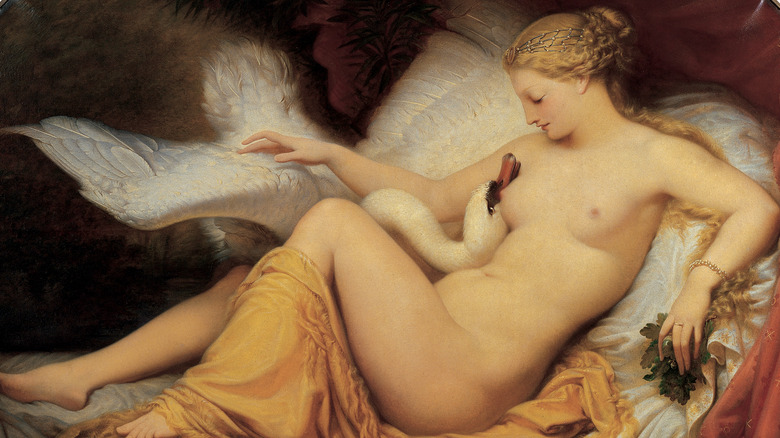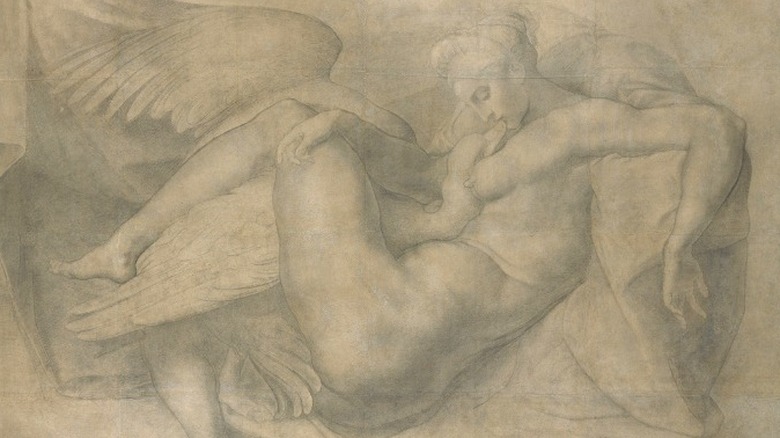The Real Reason We Can't Find Michelangelo's Lost Leda And The Swan
In the 1530s, a middle-aged Michelangelo was preeminently preoccupied with a high-paying gig painting the ceiling of the Sistine Chapel. The Sistine Chapel commanded intense concentration, presumably, but Michelangelo did not have a reputation for running short of creative wit. Despite his concurrent commitment to what would become his legacy masterpiece, all artists have side projects, and as a quintessential "Renaissance man," Michelangelo was no exception. During the Sistine Chapel project, the legendary painter also dedicated his time to other works — including one that's now lost to history. The painting, Leda and the Swan, has not been seen for hundreds of years.
Leda and the Swan is a quintessential trope portrayed by a wide breadth of artists, with mosaics of the subject matter appearing as early as the first century A.D. in Rome. The classical vignette of a woman looking tenderly at a swan comes from a Greek myth. In the myth, Zeus (or Jupiter) seduces Leda by appearing to her in the form of a swan. A Gallery statement from the Herbert F. Johnson Museum of Art recounts this version of the myth from Ovid's "Metamorphoses." Michelangelo, a website dedicated to chronicling the artist's career, chronicles the Greek version, with a much more ominous ending.
A copy of a copy of a copy of the Leda and the Swan
The Leda and the Swan vignette has been portrayed by artists from Correggio to Da Vinci, with the Leda belonging to Da Vinci also ending up mysteriously lost (via Herbert F. Johnson Museum of Art). Michelangelo created his own interpretation of the iconic Leda trope. In the painting, a nude redheaded woman curls up like an embryo, looking down in tender fascination at a swan nestled against her breast — its wings, majestic and large, spread emerging between her thighs. This, at least, is what surviving imitations of Michelangelo's presumed masterpiece-to-be portray. The original work itself is lost to time and the complicated commerce of art dealings in Renaissance Europe.
According to the Herbert F. Johnson Museum of Art and the Royal Academy Collection, Michelangelo's original Leda and the Swan painting was known to be at the palace of King François I of France, a lover of Italian art, and presumably sold to him by Michelangelo's pupil Antonio Mini (or so the prevailing theory, popularized by art historian Giorgio Vasari, has it). The painting was inducted to the royal collection at Fontainebleau in the early 1530s. Francois I's court painter Rosso Fiorentino created a copy of the original work for his collection, but both Fiorentino's copy and Michelangelo's original panel painting have been lost to history. The only surviving imitation of Michelangelo's rare painting is an engraved print composed by the Flemish artist Cornelis Bos (via Herbert F. Johnson Museum).
The Lascivious Leda's Hypothetical Incineration
Michelangelo's original preparatory sketches for the Leda and the Swan, however, did survive. Michelangelo's Leda is reportedly sketched from observing the profile of a male model wearing a tight-fitting cap. Michelangelo's sketches are known for their detail and remarkable composition, rendering these surviving artifacts nearly priceless, even if the painting itself is lost to time (via Web Gallery of Art).
According to the Royal Academy Collection, the painting is rumored to have been destroyed by Queen Anne of Austria. Surviving documents from a 1691 inventory of the French collection record a Michelangelo drawing "representing a Leda," alongside instructions that it is to be burned for its "lasciviousness." Although historians can't prove the painting was incinerated by Queen Anne, it hasn't been seen since. A copy of Michelangelo's Leda and the Swan, painted by an unknown 16th-century artist, is on display at the National Gallery in London. While we're not sure how precisely this copy resembles Michelangelo's original, thanks to tumultuous events of history, the National Gallery's anonymous work is the closest thing we've got.


